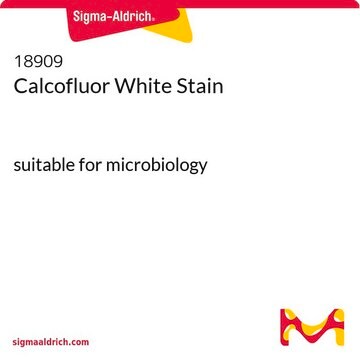D9542
DAPI
for nucleic acid staining
Synonym(e):
4′,6-Diamidin-2-phenylindol -dihydrochlorid, 2-(4-Amidinophenyl)-6-indolcarbamidin -dihydrochlorid, DAPI -dihydrochlorid
About This Item
Empfohlene Produkte
Qualität
for molecular biology
Assay
≥98% (HPLC)
Form
powder
Methode(n)
transfection: suitable
Löslichkeit
H2O: 20 mg/mL
PBS: insoluble
ε (Extinktionskoeffizient)
30 at 263 nm in H2O at 1 mM
Fluoreszenz
λex 340 nm; λem 488 nm (nur DAPI)
λex 364 nm; λem 454 nm (DAPI-DNA-Komplex)
Eignung
suitable for fluorescence
Lagertemp.
2-8°C
SMILES String
Cl.Cl.NC(=N)c1ccc(cc1)-c2cc3ccc(cc3[nH]2)C(N)=N
InChI
1S/C16H15N5.2ClH/c17-15(18)10-3-1-9(2-4-10)13-7-11-5-6-12(16(19)20)8-14(11)21-13;;/h1-8,21H,(H3,17,18)(H3,19,20);2*1H
InChIKey
FPNZBYLXNYPRLR-UHFFFAOYSA-N
Suchen Sie nach ähnlichen Produkten? Aufrufen Leitfaden zum Produktvergleich
Verwandte Kategorien
Allgemeine Beschreibung
Anwendung
- DNA-Färbung in Agarosegelen
- Analyse von DNA-Veränderungen während der Apoptose
- Nachweis von Mykoplasmen
- Photo-Footprinting von DNA
- Immunfluoreszenzfärbung von Zellen
DAPI wird verwendet:
- zur schnellen Überwachung von mikrobiologischen Kontaminationen
- bei der Chromosomenbänderungstechnik
- zum Nachweis von apoptotischen Zellen
- bei der Fluoreszenzmikroskopie zum Nachverfolgen der DisA (DNA-Integritäts-Scan-Protein)-Bewegung auf Bacillus subtilis-DNA
- zum Färben von ausgereiften Pollenkörnern (0,5 mg/ml)
Biochem./physiol. Wirkung
Vorsicht
Ähnliches Produkt
Signalwort
Warning
H-Sätze
Gefahreneinstufungen
Skin Irrit. 2 - Skin Sens. 1A - STOT SE 3
Zielorgane
Respiratory system
Lagerklassenschlüssel
11 - Combustible Solids
WGK
WGK 3
Flammpunkt (°F)
Not applicable
Flammpunkt (°C)
Not applicable
Persönliche Schutzausrüstung
Eyeshields, Gloves, type N95 (US)
Analysenzertifikate (COA)
Suchen Sie nach Analysenzertifikate (COA), indem Sie die Lot-/Chargennummer des Produkts eingeben. Lot- und Chargennummern sind auf dem Produktetikett hinter den Wörtern ‘Lot’ oder ‘Batch’ (Lot oder Charge) zu finden.
Besitzen Sie dieses Produkt bereits?
In der Dokumentenbibliothek finden Sie die Dokumentation zu den Produkten, die Sie kürzlich erworben haben.
Kunden haben sich ebenfalls angesehen
Artikel
Cell cycle regulates vital processes like DNA repair, cancer prevention. Four stages: G1, S, G2, M. NTPs don't permeate membranes.
Available Fluorescent in situ hybridization (FISH) procedures, reagents and equipment.
Verfügbare Verfahren zur Fluoreszenz-in-situ-Hybridisierung (FISH), Reagenzien und Ausstattung.
High titer lentiviral particles for LC3 variants used for live cell analysis of cellular autophagy.
Protokolle
ICC Cell Capture Imaging Reagent simplifies imaging, ideal for rare cell and low cell count samples.
Verwandter Inhalt
Step-by-step protocol for generating apical-out human gut organoids for microbiome, ADME/Tox, viral and gastrointestinal related disease research. See the complete organoid culture protocol.
Three-dimensional (3D) printing of biological tissue is rapidly becoming an integral part of tissue engineering.
Unser Team von Wissenschaftlern verfügt über Erfahrung in allen Forschungsbereichen einschließlich Life Science, Materialwissenschaften, chemischer Synthese, Chromatographie, Analytik und vielen mehr..
Setzen Sie sich mit dem technischen Dienst in Verbindung.












